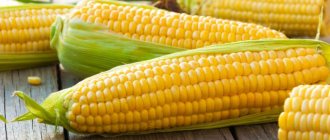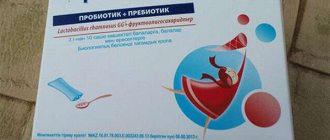When to add to your diet
A child under one year old should be given new foods carefully. The digestive system has not yet fully formed; many enzymes are missing. Therefore, complementary foods are added gradually. Doctors recommend introducing green vegetables to your baby when he already eats regular food, knows how to chew, and regularly consumes purees and soups. One must also consider whether he has allergies, since this is an allergenic product.
Children's doctors have different views on the question of at what age greens can be eaten. But the majority believes that it is undesirable to give it before 8 months. An eight-month-old baby can be given dill to try after heat treatment. It is added to soups, mixed with vegetable or meat puree.
The greens should be finely chopped and added to the dish 2-3 minutes before they are ready. After this, cover with a lid to preserve the vitamins.
It is advisable to give parsley to children after they get used to dill. It is recommended to add a little to the soup at 10-11 months. For the first feeding, 5 g or one small twig per day is enough. After a year, you can introduce your child to boiled spinach, green onions, and sorrel. The amount can be increased to 10 g, but do not overuse it.
It is not recommended to give fresh greens to a child at this age because of their pungent odor and strong effect on the digestive system.
You can add it to salads only after 1.5 years. First, the baby is introduced to fresh dill, then to parsley, green onions, and lettuce. Fresh spinach can be introduced into the diet after 2 years.
At what age can the plant be given and when are infants allowed to use it?
Dill can be introduced into your baby’s diet after eight months. You should start adding a small amount to your child’s purees and soups at first, increasing over time. Dill goes well with meat, fish, and all types of vegetables; it can be added to almost any dish and this will only be a big plus.
When your baby tries the dish, monitor his reaction to see if he feels worse or has an allergic reaction on his body. If the reaction is negative, dill should be excluded from the menu. If he feels comfortable, you can safely start introducing dill into the diet. Tea or dill water can be given to the baby after 28 days of life.
The benefits and harms of dill
Dill is the first green for children, as are its seeds. Many babies are introduced to it from an early age. Dill water helps children with colic and bloating, and improves digestion thanks to its special seeds. Dill leaves are recommended to be introduced from 8 months.
Dill is very beneficial for children's health. It contains vitamins C, A, folic acid, calcium, magnesium, phosphorus, iron and other nutrients. The beneficial properties of dill for children are:
- improves digestion, eliminates flatulence and bloating;
- used to increase appetite;
- calms, normalizes sleep, makes it easier to fall asleep;
- strengthens the immune system;
- promotes the proper development of the skeleton, teeth, vision, and improves skin condition.
How much and how to give dill water to newborns
But for some children, dill may be harmful. It is not recommended to use it for congenital diseases of the cardiovascular system. Large amounts of dill can cause intestinal upset or low blood pressure. And due to the presence of essential oils, some people experience allergic reactions to it.
Can a child have parsley?
Parsley is becoming a good choice as one of the first complementary herbs. The approximate age for introducing parsley into baby food is 8 months.
Herbs can liven up baby foods, and using them is a great way to expand baby's taste buds by introducing interesting flavors from a very young age. It is important for parents to decide which seasoning to introduce first: parsley or dill. The product is introduced into complementary foods according to all the rules of waiting from 4 to 7 days. We carefully monitor the reaction from the child’s body; any new manifestations, loose stool, skin rash or redness, swelling, lead to complete withdrawal of the product and an attempt to introduce it again after 2-4 weeks.
The daily dosage of parsley is no different from dill, so you should not overload the dish with parsley, no more than 5 grams is the daily allowance for a child under 1.5 years old, after this age you can increase the dosage to 10 grams. Once your child is 2-3 years old, you can add raw parsley to his food. Make sure to rinse the leaves thoroughly when serving raw greens. You can also try adding parsley to other baby foods.
True, with parsley everything is individual, since American pediatricians suggest giving it to babies boiled from 8 months, and giving it fresh from 9 months. Therefore, parents themselves decide what to do with parsley in baby food. If the summer season allows you to use your own parsley from the garden, the baby tolerates it well in its boiled form, then you can try giving one leaf of fresh parsley before 1.5 years.
Again, parsley is a herb that not every adult will eat in its pure fresh form, so the baby may simply not like its taste and refuse to eat it fresh. The main thing is to observe the measure, do not offer your child more than 10 grams of this product per day, this is about 1-2 sprigs of parsley.
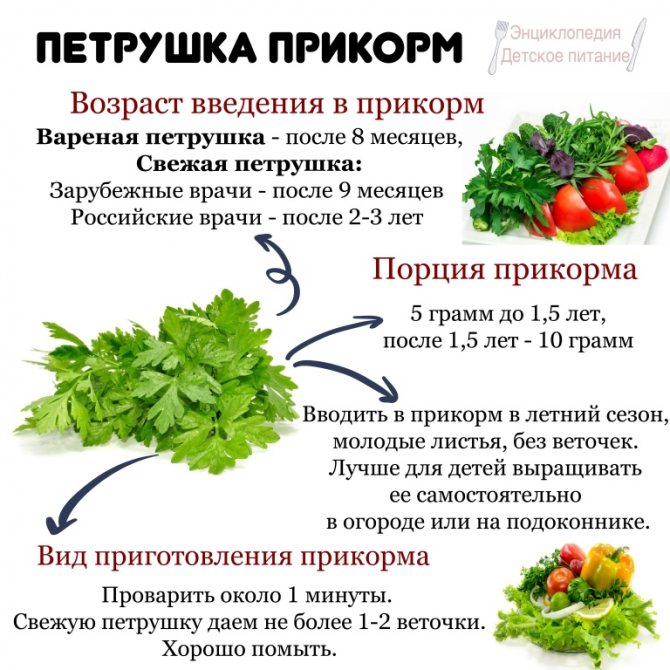
parsley complementary foods
What are the benefits of parsley?
Parsley is given to children later, as it often causes allergies. If it is well tolerated, you should include it in the child’s diet as often as possible. After all, it has the following beneficial properties:
| thanks to the large amount of vitamins C, A, folic acid in the composition, it strengthens the immune system |
| contains a lot of calcium, therefore contributes to the proper formation of the skeleton |
| has a diuretic effect |
| improves blood composition |
| normalizes digestion and metabolic processes |
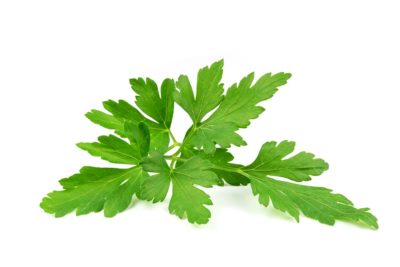
It is not recommended to give parsley to babies with congenital kidney diseases. And a nursing mother needs to remember that it contains a lot of essential oils, so it can change the taste of the milk.
Benefit

The rich composition of parsley determines many of its beneficial properties.
The biochemical composition of parsley determines the numerous beneficial properties of this aromatic seasoning, most of which are preserved even after short-term heat treatment:
- Essential oils have a pronounced anti-inflammatory effect and increase resistance to viral diseases.
- The circulatory system is strengthened: the elasticity of the walls of blood vessels increases, the concentration of homocysteine, which causes damage to the walls of arterial vessels, decreases.
- The high content of vitamins A and E with their antioxidant properties allows you to cleanse the body of waste and toxins. This promotes accelerated healing of damaged tissue.
- The presence of iron, folic acid and chlorophyll in greens causes an improvement in blood composition, an increase in hemoglobin levels, and has a positive effect on anemia in a child.
- By cleansing the body of toxic substances, the skin becomes clear, the amount of acne in teenagers decreases, and freckles disappear.
- Eating parsley helps reduce the acidity of gastric juice.
- It has a mild diuretic property, so it is recommended to give it to children with heart failure with edema.
- The presence of potassium and magnesium in green seasoning promotes normal heart function and normalizes muscle tone. The seasoning lowers blood pressure.
- Parsley, which has a bactericidal effect, will be a good addition to anti-inflammatory drugs for the treatment of pyelonephritis and cystitis.
- There is also a lot of vitamin K, which increases blood clotting: 2 teaspoons of greens contain a dose equal to the daily requirement.
- Parsley helps improve digestion, increase appetite, and has a good effect on flatulence (bloating due to increased gas production) and dyspepsia.
- Vitamin K, the daily dose of which is contained in only 2 tsp. parsley, improves blood clotting.
- Thanks to the presence of the natural antioxidant luteolin in greens, metabolism in the body is activated, the breakdown of hyaluronic acid, which is responsible for the strength of cartilage and the elasticity of tendons.
- Parsley has a positive effect on visual acuity and reduces eye fatigue.
What other greens can you use?
After a year, you can start giving your baby other greens. First boiled, then in salads or smoothies. In addition to the common parsley and dill, other types are allowed.
- Green onions strengthen the immune system and protect against viral diseases. Contains a lot of vitamin C and phytoncides. May irritate the gastric mucosa, do not give too much.
- The salad contains a lot of folic acid and vitamins. It improves digestion, normalizes the functioning of the nervous and cardiovascular systems, and has a diuretic effect.
- Spinach contains a lot of protein, vitamin C, folic acid, and calcium. It improves immunity and strengthens bones. But it is not recommended for diseases of the digestive system; it often causes allergies.
- Sorrel helps with constipation, stimulates the production of bile and food enzymes. But due to the large amount of oxalic acid, it is not recommended to give it often. Only young leaves can be used.
- Mint calms, normalizes sleep, helps cope with stress.
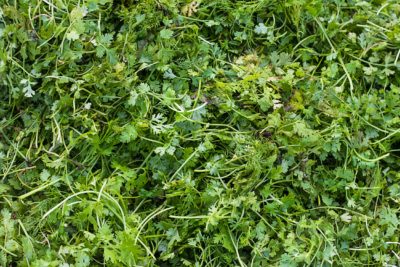
Spices in children's diet
Adults cannot imagine dishes without salt, spices, and various seasonings, but is it possible to saturate the taste of dishes prepared for a child with them? The addition of new taste sensations to dishes occurs due to other aromatic substances of natural origin: spices and herbs. Let's talk about them today

Irina Gracheva, pediatrician, consultant on child nutrition: In general, you need to be more careful with spices: a number of spices contain aromatic acids and tannins, which can be dangerous for the undeveloped gastrointestinal tract, the mucous membrane of the stomach and intestines of the child. In addition, spices are very allergenic. I would recommend consulting with a pediatrician and an allergist before introducing certain spices into your diet. But when it comes to hot seasonings, here I am extremely categorical: chili, horseradish, mustard and cayenne pepper should not appear in a child’s diet until at least 7 years of age.
During the period when the child consumes exclusively mother's milk and infant formula, there should be no seasonings in his diet. They can cause microelement imbalance in the body and even burn the mucous membrane. As your child gets older, you can gradually introduce spices that are new to your child.
What spices and at what age can a child use? Fennel
- Use in children's teas and soups from 4 months.
- Useful for mothers to increase the amount of breast milk and for children, because... is an excellent remedy for flatulence, colic, colitis, strengthens the immune and nervous systems, and also helps the baby’s intestines.
Dill
- Add from 10 months.
- It contains carotene, essential oils and many vitamins.
- They should be used to season children's soups and meat and fish dishes.
Parsley
- Add from 10 months, and from one and a half years you can add parsley fried in olive oil.
- It is rich in vitamin C, contains many salts of phosphorus, calcium and magnesium, and has anti-edematous properties. Pediatricians often advise adding parsley to children's diets if the baby has neurological disorders.
Garlic
- Add from one and a half years.
- It is a natural antibiotic, strengthens the immune and skeletal systems, normalizes heart function and improves the digestion process.
- Ideal for soups and vegetable purees.
Basil
- Add to a child no earlier than two years old.
- Relieves spasms in the baby's gastrointestinal tract, prevents flatulence.
- A mixture of basil and rosemary makes a great substitute for pepper.
Cinnamon
- Add from two years.
- Cinnamon promotes digestion, improves appetite, and has bactericidal properties.
- Pairs perfectly with apple flavour.
Ginger
- Add from two years.
- Increases immunity, normalizes the functioning of the digestive system, helps in the treatment of ARVI. Recommended by doctors during the postoperative period.
- For children, it is best added to the diet in the form of ginger tea.
Pepper
- Add black pepper at the age of 5, not earlier: it is a strong irritant for a child’s stomach.
- Sweet green and red peppers are allowed for children from one and a half years old, provided that the child does not have allergies. These types of peppers are rich in vitamins and beneficial microelements, stimulate appetite, and are indispensable for vitamin deficiency.
- Be sure to consult with your pediatrician before introducing pepper into your child’s diet, since the presence of coarse fiber and essential oils in it can negatively affect the baby’s condition during illness.
- Available exclusively from 7-8 years old, because Horseradish is too spicy a seasoning for sensitive mucous membranes of children.
- The vitamin C content is even higher than lemon. Rich in minerals, fiber and carotene, contains natural antibiotics.
Mustard
- Allowed only after consultation with a pediatrician.
- Increases appetite, helps normalize digestion, has a laxative effect, and has antimicrobial and antifungal properties.
- Attention! Excessive consumption of mustard can cause shortness of breath and heart rhythm disturbances.
Spices contraindicated for children:
Avoid buying multi-component spice mixtures for your child. Such mixtures often contain chemical flavor enhancers (in particular, unhealthy monosodium glutamate ), which are unacceptable in a child’s diet, because. may adversely affect the baby's health.
Greens for a child: when to introduce which ones?
To ensure that your baby’s diet is saturated with useful microelements and vitamins, you can add greens to children’s dishes. By the way, some herbs can be offered from almost eight months.
Despite the fact that now is not the time for fresh vegetables and fruits that you can safely offer to your baby, you still really want to fill his menu with healthy vitamins. But where can we get them if there is still nothing but radishes in our latitudes in May? Offer your baby greens, which can safely complement the taste of dishes during the introduction of complementary foods.
We can talk endlessly about the beneficial properties of greens. It contains a lot of vitamins that are quickly and easily absorbed, a lot of microelements, antioxidants and other substances that a growing body needs to form and develop, and also help strengthen the immune system.
Harm and contraindications
You should not overuse celery. It is not advisable to give it to children with chronic diseases of the digestive tract (especially gastritis, colitis). It is introduced very carefully into the diet in the presence of inflammatory kidney disease. The plant should not be given to a child on an empty stomach.
Contraindications:
- individual intolerance to the product;
- stones in the urinary system;
- hemorrhagic vasculitis (inflammation of microcirculatory vessels);
- high blood pressure;
- predisposition to sudden seizures (epilepsy).
Dill
This familiar herb is especially valuable when the delicate “Christmas trees” are just beginning to rise above the ground, emitting an aroma, as if telling everyone that they are full of vitamins.
- There are a lot of useful substances in dill. First of all, we are talking about vitamin C, beta-carotene, vitamins B1, B2, PP, folic acid. And you can’t count how many valuable minerals and trace elements it contains!
- Dill is growing by leaps and bounds. Hurry to please the kids: when the stems grow above 15 cm, the greens no longer taste the same, they are rough.
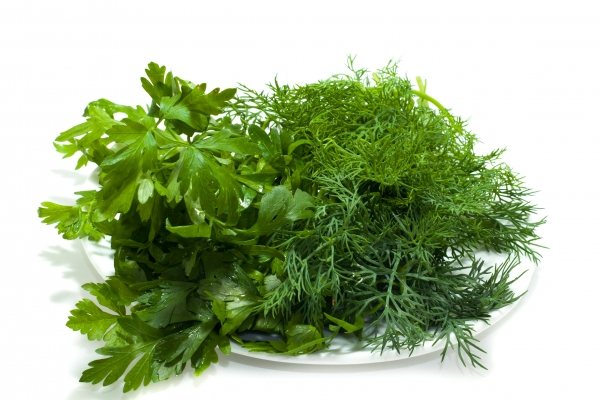
Source: Fotolia.com


